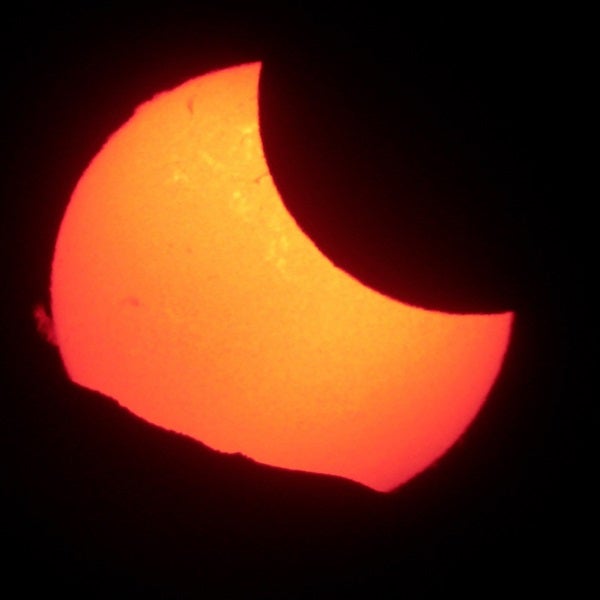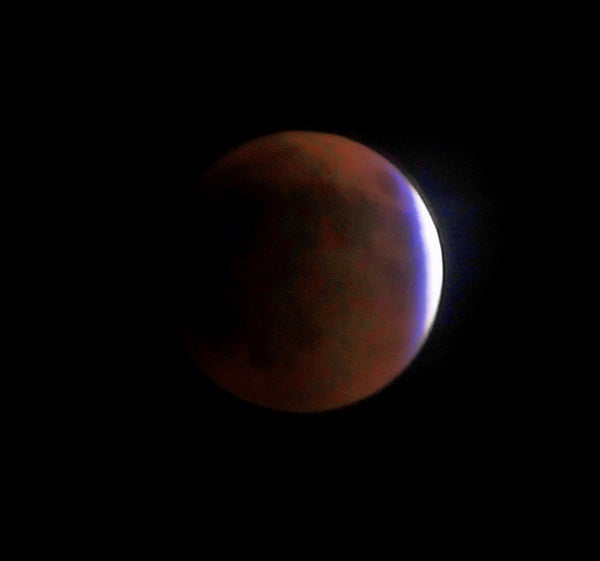Spring 2022 was an exciting period for eclipses, both solar and lunar. This comes as no surprise since such eclipses always occur in pairs, two weeks from one another. The spring events opened the 2022 eclipse season and each had their delights — and a repeat performance is on its way.
A Sun swallowed
South America and Antarctica were the only major land masses where one could see the April 30 partial solar eclipse, and even then, it was visible only shortly before sunset. In Argentina, Leo Cavagnaro and three friends traveled 90 minutes from their home in Mendoza City to view the eclipse from the lovely Valle de Uco in Tupungato — a region in central west Mendoza noted for its vineyards. The eclipse started at 5:38 p.m. local time with the Sun only about 14° above the horizon.
“We were lucky to have a perfectly clear sky and without strong wind,” says Cavagnaro, who used a 60mm double stack Hydrogen-alpha (Hα) Lunt telescope to record the eclipse with a Canon digital camera attached using eyepiece projection.
The view was outstanding. It was as if the Sun didn’t stand a chance, devoured by both Earth and the Moon as it set behind the distant Andes. “The Sun was pretty active with several prominences visible all around the Sun,” Cavagnaro says.
One magnificent example appeared at the limb opposite the one being eclipsed by the Moon as the Sun set behind the Andes. “It was a dramatic view,” Cavagnaro says, “as if that limb was releasing a mighty roar as it was being boxed in by the Earth and Moon.”
Throwing shade on the Moon
The May 2022 total lunar eclipse may be the darkest since that of Dec. 9/10, 1992, which occurred after the powerful 1991 Mount Pinatubo eruption in the Philippines. On the Danjon scale of brightness and color (from L = 0 to 4, with 0 being the darkest and least colorful), the December 1992 totality had a Danjon value of L = 0.5 to 1.0. For the May 2022 event, David Levy of Vail, Arizona, estimated a Danjon value of L = 1.5. Harvard University astronomer Dan Green, observing in St. Louis, Missouri, found the eclipse at mid-totality to be about magnitude –1.5 (or roughly as bright as Sirius) — quite the drop from the Full Moon’s magnitude of –12.8.
May’s particularly dark totality was caused by the Moon’s passage through the southern half of Earth’s shadow, where refracted sunlight was dimmed by aerosols injected into the stratosphere by the January 2022 Hunga Tonga-Hunga Ha‘apai eruption. The dimming effect could be spied during the penumbral phases, when it was only 36 percent eclipsed; usually it is first detected when the Moon is about 60 percent eclipsed.
During the umbral phases, a nearly uniform burnt sienna color washed over the Moon’s face with little other color noticeable. Through a telescope, the umbra’s leading edge appeared steel blue almost throughout the entire umbral phases; this effect is due to light passing through Earth’s upper stratosphere and penetrating the ozone layer, which absorbs red light — thus making that section of the shadow appear blue.
Come totality, however, the Moon’s extreme southern limb (that farthest away from the umbra’s center) glowed the color of straw under a setting Sun, while the Moon’s southern highlands took on a rusty shade. To the unaided eyes, the Moon’s northern half (closest to the umbra) almost vanished into the background sky as mid-totality neared, making totality appear like a burning brand of the letter C.
By the way, on Oct. 25, a partial solar eclipse occured, favoring Europe, South and West Asia, and northeast Africa. A total lunar eclipse followed Nov. 7/8, which favored the Americas, north and east Europe, Asia, Australia, and part of Antarctica. If you made a curious observation, send it to sjomeara31@gmail.com.











